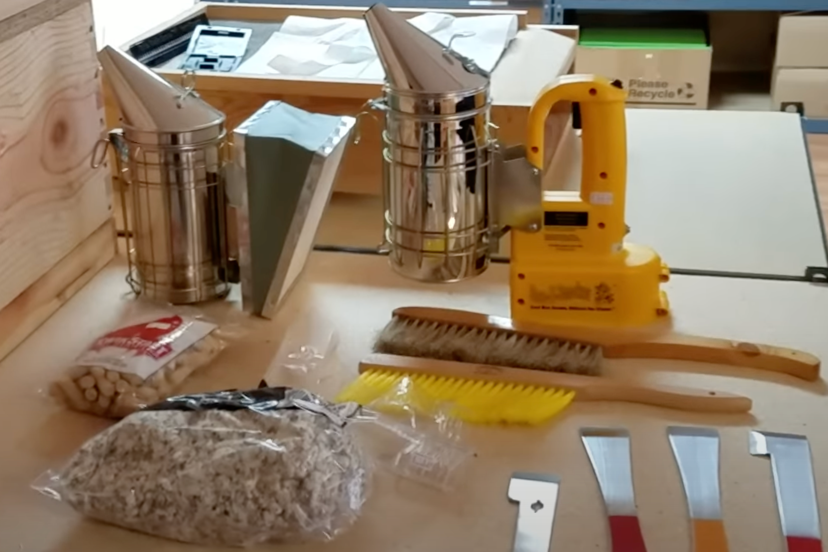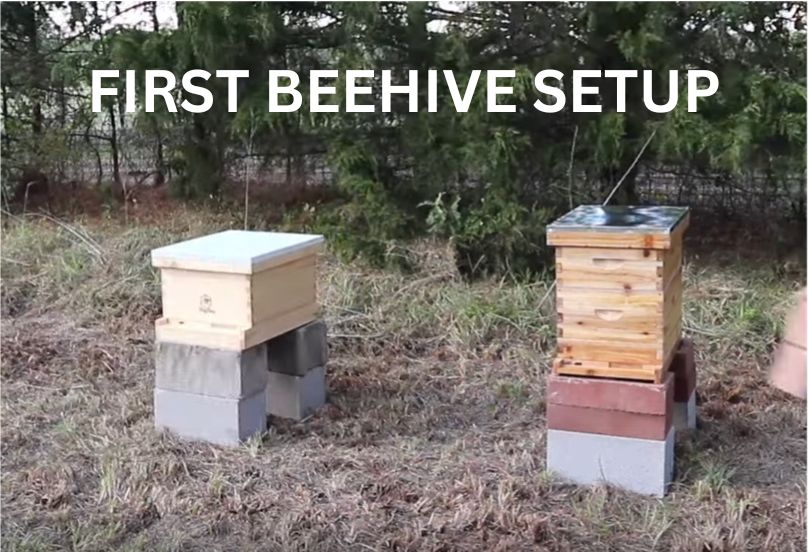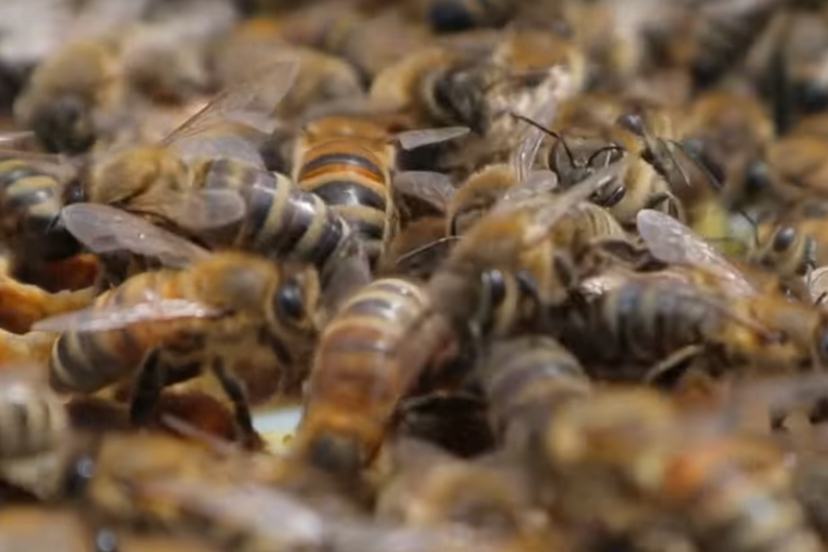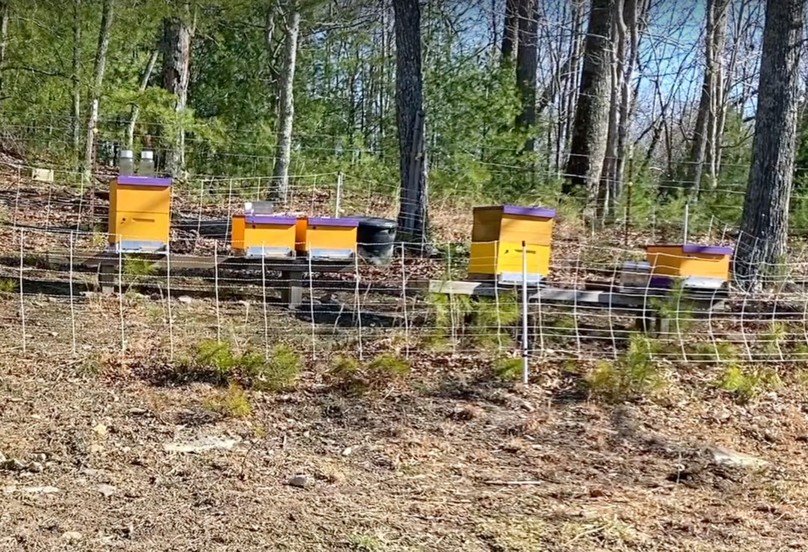Welcome, newbees! So, you’ve set up your hive and now you’re wondering, “Do I need to pack lunches for these little guys?” Well, you’re in for a treat (pun intended)!

Feeding bees might seem as simple as leaving out a plate of sugar, but there’s more to it than meets the eye. Did you know that a single bee colony can consume up to 100 pounds of honey in a year?
That’s a lot of sweet tooth satisfaction! In this guide, we’ll explore the ins and outs of keeping your buzzzing buddies well-fed and happy. So, grab your apron, and let’s get ready to become the Gordon Ramsay of the bee world!
- 1. When To Feed Your Bees: Timing Is Everything
- 2. Types Of Bee Feed: What's On The Menu?
- 3. DIY Bee Feed: Whipping Up A Bee Buffet
- 4. Feeding Equipment: Tools Of The Trade
- 5. Spring Feeding: Kick-Starting The Colony
- Why Spring Feeding Is Important
- 6. Summer Feeding: Supporting The Honey Flow
- 7. Fall Feeding: Preparing For Winter
- 8. Winter Feeding: Emergency Rations
- 9. Feeding New Colonies: Nurturing Your Newbees
- 10. Common Feeding Mistakes: Learn From Others' Oops Moments
- Neglecting Feeder Maintenance
- The Sweet Finish
1. When To Feed Your Bees: Timing Is Everything
Alright, newbie bee buffet managers, let’s talk about timing your apiary’s all-you-can-eat buffet. Because in the bee world, dinner time is serious business!
Seasonal Feeding Needs
Seasonal feeding needs are like a bee’s wardrobe – always changing. Spring is for building up, summer’s for honey-making, and fall’s for winter prep.
Think of spring as bee boot camp. They need extra fuel to get those little bee muscles ready for a season of hard work.
Summer feeding? Only if Mother Nature’s being stingy with the flowers. Otherwise, let your bees do their thing.
Fall is like sending your bees to bee college – they need brain food (aka extra honey) to survive the winter “finals.”
Signs Your Bees Are Hungry
Now, how do you know if your bees are hungry? Look for signs! If they’re raiding picnics or mugging butterflies for pollen, it might be time for a snack.
Jokes aside, check those honey stores. If the frames are looking emptier than your fridge after a midnight snack raid, it’s feeding time.
Bees clustering outside the hive? They might be plotting a grocery store heist. Better feed them before things get ugly.
Avoiding Overfeeding
But beware of overfeeding! It’s like giving a toddler unlimited candy – sounds fun, but ends in disaster.
Overfeeding can lead to honey that’s more artificial than a reality TV star’s tan. Not good for bees or beekeepers!
Too much feed can also make your bees lazy. You want industrious insects, not couch potato pollinators.
Remember, you’re a bee nutritionist, not a bee enabler. Feed with love, but also with wisdom.
Timing your feeding right is the difference between happy, productive bees and a hive full of hangry honey makers.
So grab that feeding schedule and channel your inner bee Gordon Ramsay. It’s time to serve up some gourmet bee cuisine!
2. Types Of Bee Feed: What’s On The Menu?
Let’s talk bee cuisine! It’s time to explore the fine dining options for your six-legged friends.
Sugar Syrup: The Beekeepers’ Go-To
Sugar syrup is the fast food of the bee world. Quick, easy, and oh-so-sweet – it’s the beekeepers’ go-to for a reason.
Think of it as bee energy drinks. It’ll get them buzzing faster than you can say “who spilled the honey?”
But beware, not all sugar syrups are created equal. Using brown sugar? Congratulations, you’ve just opened a bee laxative stand.
Pollen Substitutes: Protein Power
Pollen substitutes are like protein shakes for bees. They’re perfect for those gains… brood-rearing gains, that is.
These power-packed patties are the bee equivalent of spinach for Popeye. Suddenly, your worker bees think they can lift the whole hive!
Just don’t be surprised if you see tiny bee weightlifting competitions breaking out. Those protein patties pack a punch!
Honey: The Natural Choice
Honey, ah honey – the natural choice. It’s like serving bees a five-star meal made by their own personal chef.
Feeding bees their own honey? It’s like the circle of life, but stickier and with more buzzing.
But remember, honey from unknown sources is a no-no. You don’t want to introduce the bee equivalent of food poisoning to your hive.
Each type of feed has its place in a balanced bee diet. It’s like planning a menu for the world’s pickiest eaters… who happen to have stingers.
Your job is to be part nutritionist, part chef, and part mind reader. No pressure, right?
So put on that bee-themed chef’s hat and get ready to serve up some gourmet bee delights. Just don’t expect any Yelp reviews – bees are notoriously bad at typing.
3. DIY Bee Feed: Whipping Up A Bee Buffet
It’s time to don your aprons and channel your inner Martha Stewart. We’re about to turn your kitchen into a bee bistro!
Sugar Syrup Recipes
Sugar syrup recipes are the bee world’s equivalent of a smoothie bar. It’s all about that sweet, sweet nectar.
1:1 syrup is like a spring tonic for bees. It’s light, refreshing, and perfect for those post-winter pick-me-ups.
2:1 syrup? That’s your fall power punch. It’s thicker than a bad honey pun and just as likely to make your bees groan with delight.
Homemade Pollen Patties
Now, let’s talk homemade pollen patties. It’s like making Play-Doh, but edible. And for bees. So, not really like Play-Doh at all.
Mix some pollen substitute, sugar, and a bit of water. Voila! You’ve just made the bee version of protein bars.
Just resist the urge to taste-test. Unless you fancy yourself as some sort of bee-human hybrid. No judgment here.
Safe Ingredients And What To Avoid
When it comes to safe ingredients, think simple. Sugar, water, pollen substitute – it’s not exactly molecular gastronomy.
Avoid anything with additives. Your bees don’t need preservatives. They’re not trying to live forever, just till next spring.
And for the love of all things honey, skip the brown sugar. Unless you want to deal with bee tummy troubles. Trust me, it’s not pretty.
Essential oils? Sure, if you want to turn your hive into a bee spa. But use with caution – not all oils are bee-friendly.
Remember, you’re aiming for “bee nutritionist,” not “mad scientist.” Keep it simple, keep it safe.
Now go forth and concoct, you bee-utiful culinary genius! Your bees are waiting for their gourmet meal. No pressure.
4. Feeding Equipment: Tools Of The Trade
Let’s talk about setting up your apiary eatery. It’s time to get equipped!
Types Of Feeders
Types of feeders are like bee dining options. You’ve got your fast-food joints (entrance feeders), your fancy restaurants (internal feeders), and your food trucks (top feeders).
Entrance feeders are the drive-thrus of the bee world. Quick, convenient, but watch out for robber bees trying to cut in line!
Internal feeders? That’s like in-hive room service. Fancy, private, but a bit of a pain to refill. Hope you’ve been working on your yoga moves!
Top feeders are the bee equivalent of rooftop dining. Stylish, efficient, but watch your step. One wrong move and you’re wearing that syrup!
Placement And Installation
Placement and installation is crucial. It’s like real estate for bee restaurants – location, location, location!
Install your feeders level, unless you want to create the world’s stickiest waterslide. Trust me, bee water parks are not as fun as they sound.
Make sure your bees can access the feed easily. You’re running a buffet, not an obstacle course.
Cleaning And Maintenance
Cleaning and maintenance – because nothing ruins a meal like finding last week’s leftovers floating in your syrup.
Clean your feeders regularly. Think of it as running your equipment through the bee dishwasher. Except you’re the dishwasher. Sorry.
Check for leaks more often than a plumber with OCD. A leaky feeder can turn your hive into a sticky disaster faster than you can say “honey, I shrunk the bees!”
Remember, your feeding equipment is the difference between a five-star bee bistro and a greasy spoon. Choose wisely, install carefully, and clean obsessively.
Now go forth and set up that bee cafe, you remarkable restaurateur! Just don’t expect any tips. Bees are notoriously bad tippers.
5. Spring Feeding: Kick-Starting The Colony
It’s time to wake up your little striped friends from their winter slumber. No, not with tiny alarm clocks!
Why Spring Feeding Is Important
Spring feeding is like the bee version of a triple espresso shot. It’s important because your bees are groggier than a teenager on a Monday morning.
Think of it as bee boot camp. You’re the drill sergeant, and it’s your job to whip those winter bees into shape!
Stimulative Feeding Techniques
Stimulative feeding is like dangling a carrot in front of a rabbit, if rabbits were tiny and liked sugar water instead of carrots.
Start with a light syrup. It’s like serving your bees breakfast in bed, but less romantic and more sticky.
Gradually increase the amount. You’re not trying to create bee couch potatoes here!
Transitioning From Winter To Spring
Transitioning from winter to spring is like trying to convince a bear to leave its cave. It takes patience, persistence, and a lot of sweet talking.
Begin feeding before the flowers bloom. It’s like revving the engine before the race starts.
Watch the weather like a meteorologist with OCD. Too cold? Hold off. Just right? It’s feeding time!
Remember, you’re not just feeding bees, you’re staging a full-scale bee resurrection. Rise, my sugary minions, rise!
Be careful not to overfeed. You’re aiming for “productive hive,” not “bee version of Honeyland.”
With the right spring feeding, your bees will be buzzing with more energy than a kid on a sugar high. Let the pollen party begin!
6. Summer Feeding: Supporting The Honey Flow
It’s time to talk about keeping your buzzers buzzing during the hot months. No, we’re not installing tiny bee pools!
When To Feed During Summer
Feeding during summer? It’s like offering a bottle of water to a marathon runner. Sometimes necessary, often tricky.
If your bees are bringing in nectar faster than teenagers emptying a fridge, hold off on the feeding. Let them do their thing!
But if the flowers are being stingier than a miserly old bee-llionaire, it might be time to break out the syrup.
Balancing Feeding And Honey Production
Balancing feeding and honey production is like walking a tightrope… while juggling… and being chased by bears. Fun, right?
Too much feeding and you’ll end up with fake honey. Congratulations, you’re now running a syrup factory instead of a hive!
Too little, and your bees might start eyeing your sugar bowl with more interest than is comfortable. Guard your cupcakes!
Dealing With Summer Dearth
Summer dearth is the bee equivalent of a mid-summer TV rerun season. Boring, unproductive, and makes everyone a little cranky.
During dearth, your bees might act hangrier than a toddler past naptime. Time to break out the emergency rations!
Feed just enough to keep them going, not enough to make them lazy. You’re running a bee work camp, not a bee resort.
Remember, summer feeding is about supporting, not replacing. You’re the backup dancer, not the lead singer in this honey production.
With the right balance, you’ll help your bees weather the summer doldrums and keep that sweet, sweet honey flowing.
Now go forth and be the best bee summer camp counselor you can be! Just don’t expect any friendship bracelets. Bees are terrible at arts and crafts.
7. Fall Feeding: Preparing For Winter
it’s time to help your little buzzers prepare for the bee apocalypse. AKA winter.
Building Winter Stores
Building winter stores is like playing Tetris with honey frames. Pack ’em in tight, folks! No room for air guitars here.
Think of it as making the world’s stickiest panic room. Your bees need enough honey to survive the zombee apocalypse!
Adjusting Feed Consistency
Adjusting feed consistency is crucial. Time to switch from light summer cocktails to thick, hearty winter stews.
Your 2:1 syrup should be thicker than your Aunt Bertha’s “secret recipe” gravy. And probably just as mysterious to the bees.
If your syrup doesn’t threaten to break your spoon, it’s not thick enough. We’re going for “bee concrete” here, people!
Timing Your Fall Feeding
Timing your fall feeding is trickier than trying to nail Jell-O to a tree. Too early, and you’re just feeding the neighbor’s bees.
Too late, and your bees will be sending you grumpy, sugar-coated telegrams. “SEND FOOD STOP FREEZING STOP”
Start when the nights get cool and the bees start eyeing their sweater collection. Yes, bee sweaters are a thing. In my imagination.
Remember, you’re not just feeding bees, you’re creating tiny doomsday preppers. With less camo and more fuzz.
Get it right, and your bees will survive winter cozier than a bug in a rug. Get it wrong, and… well, let’s not think about that.
Now go forth and fortify that hive! Winter is coming, and your bees are counting on you to be their Jon Snow. Minus the brooding, please.
8. Winter Feeding: Emergency Rations
Alright, winter bee warriors, it’s time to talk about emergency rations. No, we’re not airdropping tiny bee MREs!
When To Feed In Winter
Feeding in winter is like trying to deliver pizza in a blizzard. Tricky, potentially disastrous, but oh so necessary. When to feed? When your bees are doing the hunger dance on top of empty frames. It’s less “Stayin’ Alive” and more “Stayin’ Hungry.”
If you hear tiny bee tummies rumbling louder than your Uncle Bob after Thanksgiving dinner, it’s feeding time!
Types Of Winter Feed
Types of winter feed are like choosing between a thick woolly sweater or a puffer jacket. Both work, but one might be overkill. Fondant is the bee equivalent of an energy bar. Dense, sweet, and makes them feel like they could survive anything. Even your amateur beekeeping.
Candy boards are like an all-you-can-eat buffet stuck to the ceiling. Upside-down dining at its finest!
Proper Winter Feeding Techniques
Proper winter feeding techniques are crucial. One wrong move and you’ll be hosting a bee popsicle party. Never, ever feed liquid syrup in winter. Unless you want to create bee ice sculptures. Trust me, it’s not as cool as it sounds.
Place your winter feed directly above the cluster. It’s not room service if they have to trek through the Arctic to get it.
Remember, winter feeding is like being a bee Santa. Swoop in, leave the goodies, and get out before they notice. No jolly “ho ho ho” required.
Get it right, and your bees will survive winter fatter and happier than hibernating bears. Get it wrong, and… well, let’s just focus on getting it right.
Now go forth and be the winter hero your bees deserve! Cape optional, but highly recommended for dramatic effect.
9. Feeding New Colonies: Nurturing Your Newbees
It’s time to talk about raising your new fuzzy bundles of joy. No, we don’t have tiny bee diapers… yet.
Package Bees Vs. Nucs
Let’s start with the age-old debate: package bees vs. nucs. It’s like choosing between adopting a newborn or a toddler. Package bees are your blank slate, ready for you to mold into your bee vision.
Nucs, on the other hand, come with some built-in street smarts and a head start on life.
Feeding package bees is like caring for a newborn: constant attention and lots of formula (sugar syrup, in this case). Nucs are more like those toddlers who insist they can feed themselves but end up wearing more food than they eat.
First-Year Feeding Schedule
Your first-year feeding schedule is going to be busier than a one-armed wallpaper hanger. Spring and summer will have you playing bee waitstaff more often than not.
Fall? That’s when you channel your inner doomsday prepper and stuff that hive fuller than your Uncle Pete at Thanksgiving dinner.
Monitoring New Colony Progress
Monitoring new colony progress is like being a helicopter parent, but with more literal buzzing. You’ll be peeking into that hive more often than a kid checks the cookie jar. Are they building comb? Raising brood? Throwing wild bee parties when you’re not looking?
Watch for signs of growth like a nervous parent tracking their kid’s height on the kitchen doorframe. More bees? Check. More comb? Check. Queen looking smug? Double-check.
Remember, feeding new colonies is a delicate balance. Too little, and your bees might pack up and leave faster than teenagers ditching a chaperoned dance. Too much, and you’ll have the insect equivalent of couch potatoes.
Now go forth and nurture those newbees! Just try not to post every milestone on BeesBook. We get it, your bees are the cutest and smartest ever.
10. Common Feeding Mistakes: Learn From Others’ Oops Moments
We’re about to dive into the hall of fame (or should I say shame?) of feeding faux pas.
Overfeeding And Its Consequences
Let’s start with overfeeding, the bee equivalent of forcing your kids to clean their plates. Sure, your intentions are good, but the road to a sticky, fermenting hive is paved with good intentions.
Overfeeding is like giving your bees an all-you-can-eat buffet ticket and then wondering why they’re too plump to fly.
The consequences? You might end up with more artificial honey than a dubious supermarket brand. Your bees could become lazier than a teenager on a Sunday morning.
And let’s not even talk about the potential for fermentation – unless you’re aiming to open the world’s first bee speakeasy.
Using The Wrong Type Of Feed
Using the wrong type of feed is like serving a gourmet chef a microwave dinner. Brown sugar in your syrup? Congratulations, you’ve just opened a bee laxative stand. Honey from an unknown source? You might as well be playing Russian roulette with bee diseases.
Remember, bees are picky eaters with sensitive tummies. Feed them right, or prepare for the bee version of a food critic’s scathing review.
Neglecting Feeder Maintenance
Neglecting feeder maintenance is like forgetting to wash your dishes… for a month. Your feeders can become petri dishes for all sorts of nasty growths. Mold, fermentation, bee soup – none of these should be on your hive’s menu.
Clean those feeders more often than a neat freak in a mud wrestling contest. Your bees will thank you by not turning into tiny, fuzzy science experiments.
Learn from these mistakes, and you’ll be on your way to becoming a bee feeding maestro. Ignore them, and well… let’s just say you might find yourself starring in the next “What Not to Do in Beekeeping” viral video.
The Sweet Finish
Congratulations, you’re now well on your way to becoming a bee culinary expert! Remember, feeding your bees is an art as much as it’s a science.
It’s about finding that sweet spot (pun absolutely intended) between supporting your colony and letting them do their natural thing.
As you embark on this journey, don’t be afraid to make mistakes – every great chef has a few kitchen disasters under their belt. Keep observing, keep learning, and most importantly, keep that sugar syrup flowing when needed.
Your bees might not thank you with words, but a thriving, buzzzing hive is thanks enough. Now go forth and feed, you magnificent bee nutritionist!




